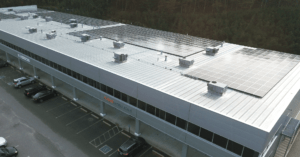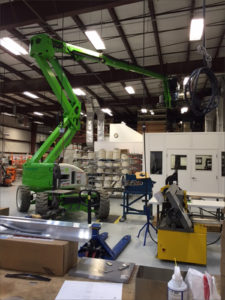What do 850 solar panels, a giant vacuum collection system, new LED lighting fixtures and a bunch of blue receptacle bins at 100 Armstrong Road in Plymouth have in common?
They are all part of Flexo Concepts’ efforts to “go green.”
Today we will talk with the engineering manager, the man behind the curtain, John Ferris, to find out the story behind these changes and how he is leading the way at Flexo Concepts when it comes to sustainability.
John, tell us about some of the things Flexo Concepts has done to reduce its carbon footprint.
For starters, Flexo Concepts installed a solar renewable energy system last year that produces 100% of the energy used by our company and the other tenants in the building. The  project, which included 850 panels on the roof, 40 power inverters and all materials required to connect the energy to the building and electric grid, was completed over five months. We are proud to say that our entire facility is now energy-independent!
project, which included 850 panels on the roof, 40 power inverters and all materials required to connect the energy to the building and electric grid, was completed over five months. We are proud to say that our entire facility is now energy-independent!
Also, two years ago, we equipped our entire facility with more efficient LED lighting. The scope of the project consisted of all Flexo Concepts’ manufacturing and administrative space as well as the parking lot and other common areas of the building complex. Every bulb in the office areas was exchanged for an LED lamp and all lighting equipment in the shop and common areas was replaced with new fixtures that contain LED lamps.
Could you describe some of the less obvious ways Flexo Concepts is leading the way in the industry with its sustainability practices?
One of my primary responsibilities as the engineering manager is to look for ways to develop products using materials and processes that don’t have a negative impact on the environment. Our R&D team and material suppliers work closely together to create polymer doctor blade materials that not only deliver performance to printers but also offer eco-friendly options to help our customers meet their sustainability goals. One of the criteria we use to select new materials and material combinations for testing is the eco-friendliness of the polymerizing methods. For example, the main polymer used to make our TruPoint Green® doctor blade is created from carbon monoxide that’s recaptured from a steel mill. If this vapor were released into the atmosphere, it would break down into carbon dioxide which is a well-known greenhouse gas.
Another example is the procedures we have in place to reduce, reuse and recycle waste throughout the company. Flexo Concepts recycles 100% of its manufacturing cardboard waste and has placed blue recycling bins at every desk and in common areas to collect office waste and food packaging. But, in addition to these more “typical” recycling practices, we have installed a central trim collection system in the manufacturing area to consolidate blade material waste. The system consists of a network of pipes from each point of plastic chip generation connected to a centralized suction machine. (As an added benefit, we found the system significantly reduced electricity usage by replacing the use of higher-amperage and landfill-disposable shop vacs at individual workstations.) The waste is then made available to be reused as filler by other industries.
John, explain how this program could be adopted by other companies in the industry.
Any company can install a solar system, LED lighting and recycling bins in their facilities. But our efforts reach beyond the bricks and mortar of our facility to the printing industry as a whole. Our customers choose plastic doctor blades in part because they help reduce their carbon footprint. Producing steel is a highly energy-intensive process that uses up large quantities of fossil fuels and releases a significant amount of greenhouse gases into the atmosphere. Producing plastic uses much less energy, emits smaller volumes of greenhouse gases, and has lower transportation requirements due to local sourcing of raw materials and its relatively lighter weight. Plastic blades, such as our TruPoint Orange® doctor blade for the tag and label market, also lasts longer than steel in the press, which results in less start-up waste and fewer order deliveries. We believe, by setting this example, we can inspire other organizations in the industry to turn to their supply chains to source more eco-friendly components.
What is unique about your approach?
Our desire is to not only pursue environmental responsibility for our company but also help our customers achieve their sustainability goals is what makes our approach different. To our knowledge, we are the only global doctor blade manufacturer that uses 100% solar carbon-free energy to power its entire facility and the only blade manufacturer that uses recaptured carbon monoxide as a feedstock in our products.
While every company wants to be able to call itself “green,” we feel we have gone above and beyond to reduce energy dependence, improve efficiency, and recycle and reuse waste across our entire organization. Plastic, as a material, has developed a negative image in society due to a culture of “throwaway living,” its limited recycling and its inability to break down in the environment. As a manufacturer of plastic doctor blades in an industry that primarily uses steel (sometimes referred to as the “most recycled material on the planet”), we are working hard to change this negative image by promoting the “green” benefits of our operations and products.
Thank you, John!
[Read how we were awarded the “Calvin Frost Environmental Leadership Award” by the Tag and Label Manufacturers Institute in October 2018!]
To learn about the environment impact of plastic vs. steel doctor blades:
[Download our infographic, “The Environmental Impact of Doctor Blades”]
[Read our white paper, “Reduce Your Carbon Footprint with Plastic Doctor Blades”]

